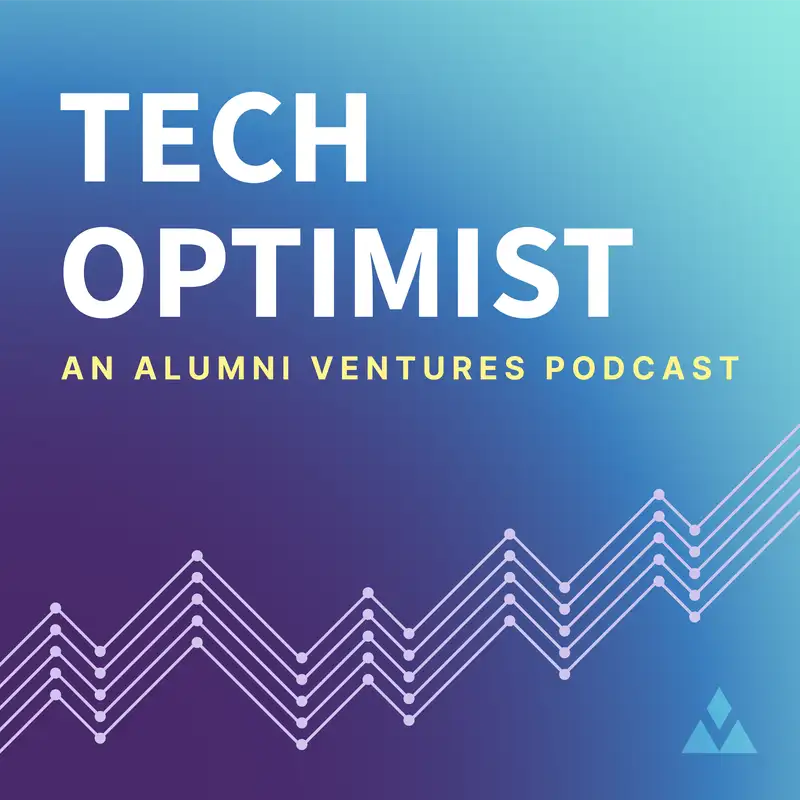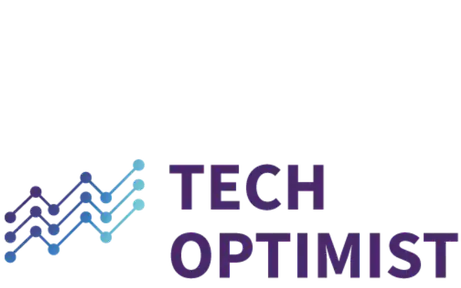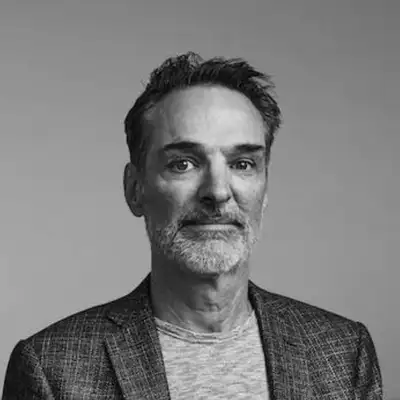#28 - The Father of Modern Rocket Science
Sam:
The God of rocket science. Who is that? My name is Sam, your guide and welcome back to the Tech Optimist.
Thomas Mueller:
The whole thought for Impulse was let's develop in-space transportation to move those things around in space.
Drew Wandzilak:
Boeing 747 example of great for taking people or cargo from New York to London, you're not going to park it in your driveway.
Thomas Mueller:
I'm super excited about what I call the true space economy developing. The earth is finite and space is infinite, so we should start using the resources of space.
Sam:
In a world captivated by criticism, it's easy to overlook the groundbreaking technologies shaping our future. Let's shine a light on innovators who are propelling us forward. As the most active venture capital firm in the U.S., we have an exceptional view of tech's real-world impact. Join us as we explore, celebrate, and contribute to the stories of those creating tomorrow. Welcome to the Tech Optimist.
As a reminder, the Tech Optimist podcast is for the informational purposes only. It's not personalized advice and it's not an offer to buy or sell securities. For additional important details, please see the text description accompanying this episode.
Drew Wandzilak:
Cool. Welcome, everyone. I am Drew Wandzilak. I'm an investor with Alumni Ventures, and joining me today on this series of great founders, technologists, entrepreneurs is Tom Mueller, the founder and CEO of Impulse Space and also founding employee number one at SpaceX. Thanks for being here, Tom.
Thomas Mueller:
Thank you for having me.
Drew Wandzilak:
Yeah. We're going to jump into a bunch of stuff in the space economy, we're going to talk about Impulse. There's a lot of great content out there about SpaceX, but we will of course maybe spend some time talking about your time there.
Let's center the audience. These are people that maybe vary from heavily interested in space to maybe they're just curious about this market. I think a great place to start is actually with your SpaceX experience. What was the environment like and the interests from the market in space as an investment, as a technology back when you started at SpaceX about two decades ago?
Thomas Mueller:
When we started SpaceX, there was a lot of naysayers. Most people didn't believe we could do it. Even I joining was like this is high risk. Is this going to go? I got to go try it, but have an exit plan because the chances were pretty low because most space startups, launch startups that had tried had already failed.
It was definitely high risk, not a hard to get investment until you've actually done a lot. Really, we didn't get a big investment until 2008 after we launches successfully after three failures, so really a whole different environment than it is now.
Drew Wandzilak:
A big part of that environment, at least in our view, is as a result of the work that you and the team did at SpaceX is the rapid ability of launch, the low cost of launch. Something like Impulse wouldn't have existed 15, 20 years ago. It couldn't have, right? Can you maybe share a little bit about the final few years at SpaceX into the origins of Impulse and what drew you to this concept, and maybe a little bit of an overview of what Impulse is because we're excited about it?
Thomas Mueller:
Sure. Basically the last six years, since the time that I became a propulsion CTO, I was working mostly on BFR, which became Starship, which was fun. I originally sized that spaceship and convinced Elon and others to change it from hydrogen fuel to methane fuel.
A fully reusable vehicle that can be flown often that can take at least 100 tons to low Earth orbit every time it flies and realizing it was going to be a thing, I was just thinking the next opportunity is going to be in space. It's going to bring a lot of stuff to space. It's basically solved the problem of getting the low Earth orbit.
Now, the next problem is going to be moving it around in orbit because most cargo loads of 100 tons are not going to be a single object, they're going to be multiple things. Think of a big cargo ship coming into port. Lots of cargo containers, they need to go to lots of different places. The whole thought for Impulse was let's develop in-space transportation to move those things around in space.
Sam:
More on Impulse Space with Drew and Tom right after this.
Pete Mathias:
Hey, everyone. Just taking a quick break so we can tell you about the U.S. Strategic Tech Fund from Alumni Ventures. AV is one of the only VC firms focused on making venture capital accessible to individual investors like you. In fact, AV is one of the most active and best performing VCs in the U.S., and we co-invest alongside renowned lead investors.
With AV's U.S. Strategic Tech Fund, you'd have access to an investment portfolio focused on technologies that are critical to bolstering U.S. national security and economic prosperity. We prioritize three key areas; homeland security, cyber AI and digital strategy, and space innovation.
By investing in companies innovating in these areas, you can support early-stage ventures and help encourage sustained growth and technological progress in the United States. If you're interested in learning more, visit av.vc/funds/strategictech.
Drew Wandzilak:
I used a Boeing 747 example of great for taking people or cargo from New York to London, you're not going to park it in your driveway. You're not going to pull it into your local town hall to deliver packages. That's really the mission of Impulse.
There's two offerings under the Impulse umbrella. There's Mira, which you guys launched your first one pretty recently, and then you have Helios, which was publicly announced a couple of months ago. What is Mira, what is Helios, and how do those two relate to each other and this grand vision that you have for the company?
Thomas Mueller:
I call Mira the stay-there vehicle. It has storable propellants, it can stay on for years because the propellants can be stored at room temperature and don't go away, but it has limited amount of Delta V it can do. In-space, movement is Delta V, like how many meters per second you could add to a body to change its orbit. Mira can do something like on the order of 1 kilometer per second of Delta V, which is great for moving around in geo, but it won't get you to the moon or to high-energy orbits.
Helios is the get-there product. It's basically adding a kick stage, almost like adding a third stage to an existing vehicle like Falcon 9, or actually several could fly on a Starship, and it can do anywhere from 4 to 10 kilometers per second of Delta. Now you're talking about able to escape earth gravity, able to go to high-energy orbits, able to go to the moon, able to go to Mars, able to speed up getting to the outer planets. It's definitely basically adding as much chemical energy impulse to a payload as possible. Just really about prime movement in space.
Sam:
I don't know if you guys know this, but I am not an aerospace engineer. I am just the podcast editor for this show and the guide for this show, so I'm going to leave the explanation to Mira and Helios up to Tom himself. I did a little bit of digging and I found this really awesome YouTube video by Ellie In Space, and what she did is she interviewed Tom in their facility. It's a really awesome video, it's just under an hour. Obviously I'm not going to share the whole thing, but I'm going to share a few snippets of it because I think it's really impactful to see how they operate, to see Tom talk about his technology and everything.
Here are a few snippets from that video from Ellie In Space, which was posted just about a month ago, so it's still pretty recent, which is awesome. I thought that they were super cool and I thought you all would enjoy. Here's a little bit more about the two projects that Tom was just previously talking about here.
Thomas Mueller:
You can see there's four thrusters on each side, those are little safe thrusters, and there's four more on that side, so eight total. That structure on the back there is the mount for the solar cells and out on the corner of the solar cells, those valves there are basically are cold gas thrusters, so they use ethane gas to point it, point the antennas at the ground and point the solar cells at the sun. When we want to do an orbit change, we point it in the right direction and burn the engines for a given amount of time and move in orbit.
Ellie:
When do you expect to launch this one?
Thomas Mueller:
This one's going up in October of this year.
Ellie:
Okay.
Thomas Mueller:
Yeah.
Ellie:
Wow.
Thomas Mueller:
It's getting ready here in the next month it's going to go to system vibes. We send it out to a company and shake it to simulate launch and then it's hands off after that because it's been tested.
Ellie:
Your first one was November 2023 on a SpaceX rocket, correct?
Thomas Mueller:
Yep.
Ellie:
Did you want to have a full year almost in between or have there been delays?
Thomas Mueller:
I think we wanted to go on 11 but for some reason, we just ended up on 12.
Ellie:
Okay.
Thomas Mueller:
Yeah.
Ellie:
Interesting.
Thomas Mueller:
Yeah, no, it's fine.
Ellie:
Very cool.
Thomas Mueller:
We're mostly working on Helios this year anyway. Last year was all about Mira, this year is mostly about Helios.
Ellie:
Okay.
Thomas Mueller:
The demo launch on that is going to be in early '26.
Ellie:
Wow. Same timing as the lander, right?
Thomas Mueller:
Mm-hmm.
Ellie:
Okay.
Thomas Mueller:
Well this will be late '26, but yeah.
Ellie:
Okay.
Thomas Mueller:
That's going to be a busy year
Ellie:
'26 will be a big year for you. If someone's never heard of Mira or is not familiar, this is like a space tug to transport from LAO to MEO, correct?
Thomas Mueller:
Yes. Well, mostly this is made to move around in low-Earth orbit. It goes up on transporter, it's optimized a fit in the transporter lower spots, and transporter dumps everybody, typically a 500 kilometer circular orbit sun-synchronous, and some people want to go to different timings or different orbits, different altitudes, and we can take 300 kilograms of things and stuff to different places. You ready to do a burn, Kian?
Kian:
Yes, sir.
Thomas Mueller:
This is our test area back here. We have the vacuum test chamber for running the little five-pounder here, we got shaker tables over here, so we simulate launch basically on components, and over there is like hard vacuum where we pull down really simulate space for avionics and things.
Ellie:
You need this big of a vacuum for a five pound thruster test?
Thomas Mueller:
Yep. Here I'll show you.
Ellie:
I guess this probably isn't that big, then.
Thomas Mueller:
It's not that big. It's about the right size actually for this. There's the thruster mounted on a thrust stand. You can hear the vents and the valve cycling. That line right there goes out to a vacuum pump out back and this vacuum gauge, we're at 1.4 tore. Atmosphere is 760 torr, 760 millimeters of mercury is what a torr is, so we're at 1.5 torr, so we're one 500th of atmosphere basically in there. It's at vacuum. The plume, it has a high area ratio. It's got 100 area ratio, so it'll expand the plume completely so we're measuring thrust.
Ellie:
What is this one called?
Thomas Mueller:
That's safe.
Ellie:
Safe, okay. I just want to make sure I didn't pronounce it...
Thomas Mueller:
Yeah, this is the one that we have. There's eight of these on a Mira, and there'll be 48 of these on the vast space station.
Ellie:
Wow.
Drew Wandzilak:
Yeah, hence the name Impulse. I think your focus on propulsion, that's the key here. For those listening that didn't at least take a couple summers of aerospace engineering classes like I did, explain the importance of that density and even Delta V, some of these terms that you're using that are so crucial I think to what you guys are doing. Someone hears that, and a kilometer a second, that's pretty fast, right?
Thomas Mueller:
Yeah.
Drew Wandzilak:
What does that mean in actuality?
Thomas Mueller:
Orbital velocity is 7 kilometers per second at low-Earth orbit. To get to higher energy orbits, that potential energy to get out of the gravity well takes... To get from low-Earth orbit to geosynchronous orbit, which say 300 kilometers at some inclination to 36,000 kilometers at the equator is about 4.2 kilometers per second, nominally.
Helios can add that much Delta V to a four ton payload in order to get it to geosynchronous orbit. The rocket equation, the very simple rocket equation only really has two factors; the performance of the engine and the mass ratio, full to empty, which basically means how much propellant you can store compared to your total structural and payload mass.
You want to make your spacecraft as light as possible, hold as much propellant as possible and have as high performance rocket engine as possible. It's that simple. We just try to make the spacecraft extremely light and try to make the performance of the engines as high as possible.
Drew Wandzilak:
Yeah, and you need that trade-off to get these larger payloads to GEO, or geosynchronous orbit. Again, I'll ask, we were talking about LEO, we're talking about GEO. Why is it so important that we get to GEO? Why does there even have to be this infrastructure that provides that? Again, for people listening, a lot operates in LEO right now.
Thomas Mueller:
If you go back before Starlink and LEO constellations became a thing. They tried back in the late 90s and the early 2000s and failed the first time around and that's why a lot of people were naysayers that Starlink would be successful. Before that was GEO. Your DirecTV dish is pointed at a geosynchronous satellite.
The fact that you point to the south because it's at the equator, which is south of North America, and geosynchronous means it has a 24-hour orbit, so it stays at the same spot in the sky relative to the surface of the earth. Super important orbit and it has been... Hughes Aircraft's been flying geosynchronous spacecraft since the 60s and really proliferated in the 70s.
That was the main way to do worldwide telecommunications was through GEO until Starlink came along, which now instead of in the order of a second of transit time, now you're talking just milliseconds. LEO becomes super important for if you want low latency, like instant internet or communications, but still the cheapest way to move bits through space is just through the GEO circuit. You could cover the whole globe with three satellites.
Drew Wandzilak:
That's why it's so special and so important. There's obviously a massive market there. Do you see GEO, with what SpaceX has done and will continue to do and what Impulse is doing now, open up GEO to new markets that we're not thinking about that isn't just moving bits around? What does this unlock?
Thomas Mueller:
If you look at the predictions for GEO, like the Euro consult numbers that we looked at or there's... Including MEO, medium Earth orbit, like the GPS orbits and above, things well above, many, many times higher than LEO. They're talking about 30 a year, we think it's actually less than that, but it's flat. It looks pretty flat.
We think by reducing the cost of access to these orbits by a pretty large amount. Certainly when Starship starts flying along with Helios, we're talking about getting the price down by at least a factor two, maybe even a factor three. We think that will increase the number of things going there. Certainly, the government missions want to go there. There's a lot of interest by the government.
Drew Wandzilak:
Fantastic. That was helpful. Great. For those listening, couldn't understand by now, Tom is the guy to talk to about this stuff. I pulled together some of the comments or reviews on posts and Tom has been described as the leading spacecraft propulsion expert, founding father of the new space economy. I even saw X reply the other day, called you the God of Rocket Science.
With those titles, with great power comes great responsibility. You have this, I think, better than most perspective on the space economy. When you look out at other space innovations outside of Impulse, what's really exciting to you? What do you feel like maybe isn't getting the attention or even investment that it deserves?
Thomas Mueller:
I'm super excited about what I call the true space economy, developing where we're manufacturing and assembling in space and then eventually using the resources in space using the water that's on the moon. There's probably at least a billion tons of water ice on the moon. There's metal and minerals on the moon and near-Earth asteroids that can be used way more efficiently, more than 20 times more energy efficiently to get that matter from the surface of the moon into low-Earth orbit than it is from the surface of the earth because of the much more massive gravity well of Earth.
I think I'm pretty excited about companies like Varta and others that are doing manufacturing and assembly and space. That's the first step. Once that really takes off, I think pretty soon, these companies are going to have enough capital to realize that getting that material from the surface of the moon or asteroids, that'll become important. That'll just be the way to do it. That basically that offloads the resource drain on Earth because the earth is finite and space is infinite, so we should start using the resources of space.
Drew Wandzilak:
Yeah, absolutely. There's so much opportunity out there and stuff like Impulse is going to I think unlock a lot of these markets that we wouldn't even be thinking about. Coolest space tech you've seen? I feel like 20 years ago we were talking about potentially hover cars or teleportation. When you look out there, what's the coolest thing that might fit into a Star Trek episode but actually is closer than people would think?
Thomas Mueller:
It is got to be Starship. Starship is so exciting. It's going to transform access to space. It's hard to beat that one.
Drew Wandzilak:
Yeah. I think people, and when I first heard about Starship a long time ago, you think of this step function above in size compared to a Falcon 9, which I think people are used to seeing now. Can you quantify the scale of how big Starship is and then just really what that means? We touched on it earlier, but really what that means and why it is this big breakthrough that you're mentioning it is?
Sam:
More about Starship right after this.
Speaker 7:
Do you have a venture capital portfolio of cutting-edge startups? Without one, you could be missing out on enormous value creation and a more diversified personal portfolio. Alumni Ventures, ranked a top 20 VC firm by CB Insights, is the leading VC firm for individual investors. Believe in investing in innovation. Visit av.vc/foundation to get started.
Sam:
Really quick before Tom tells us how big of a milestone and how big of an achievement Starship is, Starship recently put out a hype video for their fourth flight test. They put out this video a week ago, as of when I'm editing this episode, it already has a million views. I watched it myself because I was curious and it gave me goosebumps.
Just the way that it's edited and produced and you see all the reactions from the crew within Starship and in SpaceX that worked on this for so long and have put blood, sweat, and tears into this and it just makes you root for them as engineers, and designers, and technicians, it's just really cool. I'm going to share that first to prep you for Tom's response to Drew's question about how impactful that is. I'm hoping that you guys get goosebumps too because I did, and then it'll help you really understand what Tom is saying after this, after you see this see/hear this.
Again, if you want to see the video, we'll have a link to it in the show notes, but also the video is on the video origin of this podcast if you want to hop over to YouTube or any of our socials to find it that way. Here's that video from SpaceX of Starship from their fourth flight test from about a week ago.
Speaker 7:
Intentional operators on countdown one. This is the final go, no go poll for Starship flight four. Stage one?
Speaker 8:
Go.
Speaker 7:
Stage two?
Speaker 8:
Go.
Speaker 7:
Eight by two?
Speaker 8:
Go.
Speaker 7:
Flight directors go for launch. We have liftoff. Vehicle is pushing down range.
Speaker 9:
[inaudible 00:23:46].
Speaker 7:
Max Q. Vehicle is supersonic. Booster engine cut off. Ship ignition. Stage separation confirmed.
Speaker 10:
Hot stage confirmed. Ship under its own power.
Speaker 9:
[inaudible 00:24:08].
Speaker 11:
You of the jettisoned hot stage. Booster, the primary goal today is to do a landing burn and a splashdown in the water. You can see those grid fins on your left hand screen rotating and turning to guide the booster. There's that landing burn! We have Splashdown!
Speaker 7:
Ship engine cut off.
Speaker 11:
Our primary goal is to get through the extreme heat of Starship reentry.
Speaker 7:
Starship is approaching entry interface.
Speaker 12:
Starship is passing through 100 kilometers altitude. Good altitude for entry. Vehicle is passing through 85 kilometers altitude. Flaps have control of the vehicle. Vehicle is approaching maximum entry dynamic pressure. External temperatures are dropping. Starship is in landing burn. Starship landing burn shutdown.
Speaker 8:
What?
Thomas Mueller:
As far as just height and volume, it's slightly bigger than the Saturn 5 moon rocket. It's got twice the thrust of the moon rocket, it can lift more to LEO than the moon rocket. The next version of it will be able to lift more than the Saturn 5, but the Saturn 5 was completely expendable. It was all thrown away, whereas Starship can be flown again.
Elon talks about the cost of flying Starship to be less than the cost of flying Falcon 1, the single engine rocket that we flew, first Rocket we flew, which we sold for $6 million. He's talking about doing what $10 billion vehicle could do for like $6 million, so it's quite an advancement for the last 50 years.
Drew Wandzilak:
Yeah, I don't think... I would say easily, most people don't understand the impact that that's going to have. Also just the increased cadence, what SpaceX is going to be able to do with just the Falcon 9 and heavy and so it's going to be a pretty interesting trajectory over the next couple of years to couple decades.
Thomas Mueller:
I talked to an investor the other day that didn't even know what Starship was, and I was surprised. My thought was you shouldn't be investing in space if you don't even know what Starship is.
Drew Wandzilak:
No, no. I think what I've learned over the last half a decade plus just looking at this market more deeply is if you don't know as intimately as you can, what SpaceX is doing, you don't know what's happening in space.
Thomas Mueller:
It's all dependent on SpaceX right now. SpaceX got it started and they're launching, I don't know what, 90% of the mass in the free world to space.
Drew Wandzilak:
Yeah, fantastic. As you again look at this broader space economy, what's missing? What are you waiting to see be developed? Whose mind are you waiting to be changed? What's that unlocker or overlooked piece of...
Thomas Mueller:
I think manufacturing in space, compute in space. If you look at just energy usage, which is driving climate change and a lot of pollution on Earth, and then you look at the growth of energy needs for AI and crypto, we're going to be at... By some estimates, by 2045, just compute, we'll be using as much energy as electrical energy generated on earth right now, and then everything else is growing also. The use of energy for everything else, even if population goes flat, per capita use of power is still going up.
At some point, it's going to make sense to move compute into space. I've been talking about it for a while, people say it's not affordable. Now I see a lot of people talk about it because it just makes sense. You can build giant solar rays in orbit, you have limitless energy, and you can just run compute space and just beam down the results. I think that's something that's going to happen that's great, and I think just manufacturing space in general and just using the resources that are in the inner solar system is just the next step.
Drew Wandzilak:
I'm glad you brought up energy. A little birdie told me the other day that you, like myself, are pro-nuclear energy.
Thomas Mueller:
Absolutely.
Drew Wandzilak:
I think both terrestrially and then also for in-space applications, and just I think important when you talk about the energy requirements moving forward. Just chat GPT alone I think uses the energy of 17,000 homes or whatnot in a day, so the demands will be there. How much can we bring compute into space where energy is resourced differently, or how do we create cleaner energy here on Earth?
This was great, Tom. I appreciate you joining. One final question is a little bit less on space and more about you as an entrepreneur. You joined SpaceX, I consider you co-founder practically. You were there at such an early time, you saw all the stuff that anyone else would've seen. You were Elon's right-hand man. Now you're in the driver's seat. Difference in your mind between those early days at SpaceX and the early days now, you obviously have this wealth experience, but things maybe you didn't foresee being the guy, the founder and CEO here?
Thomas Mueller:
Certainly, I was head down developing propulsion, rocket engines, and stuff. I wasn't involved in the investor relations or...
Drew Wandzilak:
You weren't doing podcast interviews with me.
Thomas Mueller:
Right, I wasn't doing business sales or business development. As founder and CEO of this company, and I'm CTO too, which is really probably most of what I do is still is technical, but there's just a lot more that I had to learn that I'm getting better at, certainly.
Drew Wandzilak:
Yeah, absolutely. Cool. Thank you so much for joining us, Tom. We're big fans of you guys at Impulse. I just caught up with Eric earlier today and you guys are crushing it. We're excited to be on board and thank you everyone for listening.
Thomas Mueller:
Thank you.
Drew Wandzilak:
Cool.
Sam:
Thanks again for tuning into the Tech Optimist. If you enjoyed this episode, we'd really appreciate it if you'd give us a rating on whichever podcast app you're using, and remember to subscribe to Keep up with each episode.
The Tech Optimist welcomes any questions, comments, or segment suggestions, so please email us at info@techoptimist.vc with any of those and be sure to visit our website at av.vc. As always, keep building.








